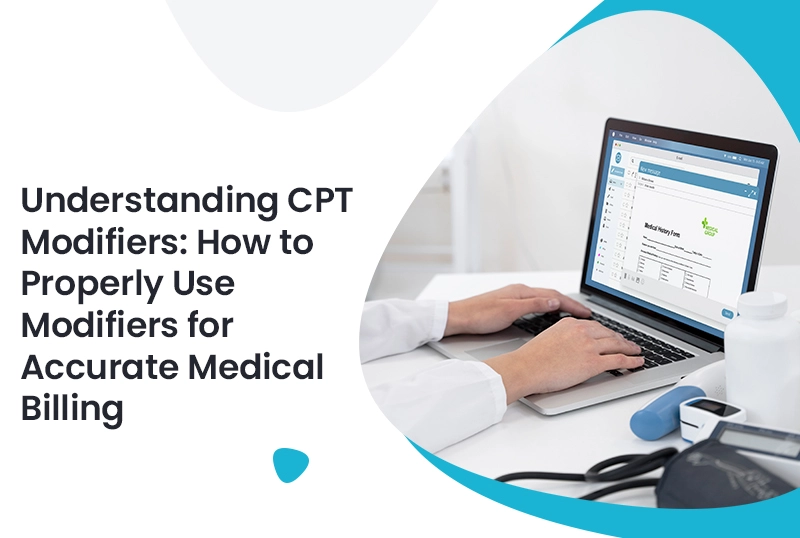CPT (Current Procedural Terminology) code helps clarify the specifics of a procedure or service, such as if a service was altered in some way without changing its definition. For small and large practices alike, accurate modifier use ensures proper reimbursement and prevents claim denials.
If you’re involved in medical coding, understanding CPT modifiers isn’t optional—it’s essential. At Precision Hub, we offer a full range of billing services medical tailored to streamline coding accuracy, modifier usage, and revenue cycle efficiency.
What Are CPT Modifiers?
CPT modifiers are two-character suffixes (alphanumeric or numeric) that provide additional context to a CPT code. These codes signal that a service or procedure was performed in a way that deviates from its standard definition, without requiring an entirely different code.
CPT Modifier Types
There are two main categories of modifiers:
- Level I Modifiers (CPT Modifiers): Maintained by the American Medical Association (AMA)
- Level II Modifiers (HCPCS Modifiers): Used mainly for Medicare and managed by CMS
Correct use of modifiers ensures that providers get paid appropriately and that the clinical documentation aligns with the services rendered.
Why CPT Modifiers Matter in Revenue Cycle Management
Misuse or omission of CPT modifiers can lead to claim denials, underpayments, and compliance risks. This is where healthcare revenue cycle management becomes critical. By integrating accurate modifier usage into your revenue processes, you can:
- Prevent revenue leakage
- Reduce compliance audits
- Improve first-pass claim acceptance rates
- Increase overall collections
Commonly Used CPT Modifiers
Let’s break down some of the most frequently used CPT modifiers and their implications:
- Modifier 25 – Indicates a significant, separately identifiable E/M service by the same physician on the same day.
- Modifier 59 – Used to denote a distinct procedural service not normally reported together.
- Modifier 51 – Signifies multiple procedures performed during the same session.
- Modifier 76 – Identifies a repeat procedure by the same provider.
- Modifier 95 – Indicates synchronous telemedicine services.
Infographic 1: “Top 5 Most Common CPT Modifiers and Their Purpose”
Design Suggestion:
- Visual icons for each modifier
- Clear definitions and examples
- Use a flowchart or column format
Modifiers to include:
- 25, 59, 51, 76, 95
Best Practices for Using CPT Modifiers
The proper use of CPT modifiers comes down to clinical documentation, coding knowledge, and billing expertise. Here’s how to do it right:
- Ensure Documentation Supports the Modifier: Always verify that the patient chart and records justify the use of the modifier.
- Avoid Overuse of Modifier 59: It’s one of the most audited modifiers due to potential abuse.
- Be Specific: Choose the most accurate modifier, especially when using newer ones like XE, XS, XP, and XU (subsets of Modifier 59).
- Keep Up with Changes: CMS and AMA update modifier guidelines frequently.
If you’re unsure how to implement these practices in your workflow, it may be time to outsource to a team that specializes in medical billing coding and compliance.
Infographic 2: “Checklist for Proper CPT Modifier Use”
Design Suggestion:
- Checklist format with green checkmarks
- Include brief explanations:
- Is the documentation complete?
- Does the modifier match the procedure?
- Is there a risk of denial?
- Has this been audited before?
- Has the payer provided any specific guidance?
- Is the documentation complete?
Real-World Example of Modifier Use
Scenario: A patient visits a provider for a check-up and receives a minor procedure during the same visit.
Incorrect Billing:
- 99213 (Office visit)
- 11055 (Removal of corn)
This would likely be denied unless properly modified.
Correct Billing:
- 99213-25
- 11055
The Modifier 25 distinguishes the E/M service as separate and significant.
Avoiding Denials and Optimizing Billing
According to CMS and other payers, improper use of CPT modifiers ranks high on the list of billing errors. Fortunately, partnering with a skilled billing team like Precision Hub can help reduce risk while boosting efficiency.
With our medical billing services, we offer:
- Ongoing compliance audits
- Regular staff training
- Expert handling of modifier complexities
- Dedicated revenue cycle oversight
Our team understands how to navigate payer-specific rules while ensuring the claims are coded for maximum reimbursement.
At Precision Hub, we blend automation with expert oversight to provide tailored healthcare revenue cycle management that keeps your practice ahead of regulatory changes.
Conclusion
Understanding and applying CPT modifiers accurately can drastically improve your billing outcomes. Whether you’re a small practice or a growing healthcare group, using the right modifiers backed by proper documentation is key to clean claims and optimal reimbursements.
At Precision Hub, our seasoned team supports every stage of the billing process, from coding audits to appeals. We’re here to help you minimize errors and maximize your returns through strong medical billing coding practices.
Frequently Asked Questions (FAQs)
Q1: What happens if I use the wrong CPT modifier?
A: Using an incorrect modifier can result in claim denials, underpayment, or compliance audits. It’s important to double-check with payer guidelines and documentation.
Q2: Is Modifier 25 always required for office visits with procedures?
A: Not always. Modifier 25 is only used when a separately identifiable E/M service is provided in addition to the procedure.
Q3: Are CPT modifiers universal across all payers?
A: Most are, but certain payers may have specific rules. Medicare, for instance, has strict guidelines for modifiers like 59 and its X subsets.
Q4: Can incorrect use of modifiers lead to audits?
A: Yes. Frequent misuse of certain modifiers (like 25 or 59) can trigger payer audits and penalties.
Q5: How do I stay updated on CPT modifier changes?
A: Follow updates from AMA, CMS, and rely on services like those from Precision Hub that monitor regulatory changes and payer trends.







